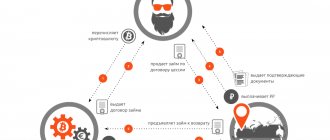Over the course of its existence, there have been many more forks of Bitcoin, but most of them did not introduce anything new - in fact, these projects were copies of Bitcoin, sometimes with minor differences.
The first known fork to create a truly separate project was Bitcoin XT.
What is a cryptocurrency fork?
A fork is a specific branch from the original digital currency (for example, Bitcoin), when a completely new coin is created with some functional changes. You can even say that a fork of a cryptocurrency is a clone, a twin brother of one or another original coin.
The new cryptocurrency (fork) is credited in a certain proportion to each investor who has a certain number of original coins in his exchange account or electronic wallet. In general, they will simply transfer a certain amount of new cryptocurrency to your account completely free of charge. And with all this, you practically don’t have to do anything. You can immediately sell the resulting fork of the cryptocurrency on the exchange, receiving your profit, or you can keep the coin in your wallet if you are confident in its future prospects.
An example of such a fork would be such a well-known cryptocurrency as Bitcoin Cash . This coin is a fork of the original Bitcoin currency. It confidently exists in the digital currency market, creating serious competition with other assets. Bitcoin Cash consistently ranks fourth in the ranking of the coinmarketcap.com in terms of capitalization. Its price is more than 1 thousand dollars per 1 coin, and at the end of 2017 the price was 4 thousand dollars. The total capitalization of the asset reaches almost $20 billion.
In general, this is a fairly serious project that is supported by a lot of investors, as well as the best cryptocurrency exchanges. And the most interesting thing is that this cryptocurrency was credited completely free of charge to all investors who, at the time of its appearance, only kept bitcoins in their electronic wallet.
In this simple way, millions of people around the world received Bitcoin Cash simply for investing their capital in Bitcoin at one time. That is, you, too, could theoretically receive it during the distribution completely free of charge and now have a very good increase in your capital.
Such distributions of forks occur very often in the cryptosphere, so this type of earnings on cryptocurrency can even be considered stable. However, despite its apparent simplicity, it is fraught with some risks and dangers. And this article will tell you how not to fall for the deception of scammers and consistently receive each fork of cryptocurrency for free, earning good money on an ongoing basis.
Bitcoin Classic
Bitcoin Classic appeared only a month later than Bitcoin Unlimited, in February 2016, but began to crumble even faster.
The creator of the fork was Gavin Andersen, the author of Bitcoin XT, who continues to pursue his goal of increasing the throughput of the blockchain by increasing the block size. This time it was planned to increase exactly twice, to 2 MB, and in another two years - to 4 MB. Andersen was also joined by Jonathan Thumim, another one of the creators of Bitcoin Core. Unlike Bitcoin XT, Bitcoin Classic was received favorably by the community. It was supported by the mining pools Antpool (Bitmain), BW.COM, HAOBTC.com, Genesis Mining, Multipool.us, as well as Coinbase, OKCoin and Foldapp. Roger Ver, owner of Bitcoin.com, also expressed his sympathy for the project - he is confident that increasing the block size will allow the creation of a larger number of full nodes, which means further increasing the decentralization of the network.
Bitcoin Classic never found any direct or vocal opponents, but it never became fully functional. The main reason why discussions have been dragging on for the second year is the need to carry out a hard fork, which will temporarily affect the overall security of the network and may result in a split. However, after the advent of Bitcoin Cash, which produces blocks up to 8 MB, the Bitcoin Classic developers said that they consider the goal achieved.
Birth of a new coin
First of all, it’s worth understanding the root causes of why cryptocurrency forks still appear. For example, a situation may arise when the developers of a particular digital asset cannot agree among themselves and make a mutual decision to improve the project. In this case, their cooperation may end there, splitting this community into two.
For example, when one part of the creators of a coin votes for a major improvement in the Blockchain code, and the second is of the opinion to leave everything as it is. And that part of the developers who proposed to overhaul the system code leaves this project and creates their own new cryptocurrency, taking into account their own desires and ideas. To do this, they take the Blockchain code of the original coin as a basis, copy it completely and on a specific block and change it. Thus, a fork of the cryptocurrency blockchain occurs. After this block, an independent blockchain appears, which begins to live its own life, but it will have a common history with the “parent”.
Even before the fork, the creators of the coin report this event on Twitter and other various social networks, talking about the advantages of the new project. They also inform the community about what block it will be created on, how many coins will be awarded to holders of the original cryptocurrency, etc.
Bitcoin Unlimited
The Bitcoin Unlimited project appeared almost six months later than Bitcoin XT - in January 2016.
He solved the same problem - increasing the block size - but in a fundamentally different way. Bitcoin Unlimited invited network nodes to independently decide what size blocks to issue. The creators relied on democracy - everyone who has a full node had the opportunity to express their opinion on what the block size should be. It was thought that the system itself would stop at the average value chosen by the majority: blocks that were too small would be “forked” from the network by the system itself, blocks that were too large would not be accepted at all, since most nodes would not see them.
The force of the free market, which rules the world of traditional economics and financial systems, was brought by the creators of Bitcoin Unlimited to serve the digital economy. The influence of the project was also added by the joining of developers Tom Zonde and Tom Harding, who left Bitcoin XT, which began to disintegrate, and another one that appeared a little later, but also did not last long, Bitcoin Classic.
Bitcoin Unlimited, like its predecessor Bitcoin XT, was not a success - the community was excited by the prospect that large centralized pools could take advantage of the proposed scheme, suppressing the opinion of the real majority of users with superior computing power. This would lead to the concentration of influence on the network in the hands of just a few groups and would invalidate the entire idea of Bitcoin as a decentralized system.
In addition, a large number of blocks of different sizes could lead to multiple involuntary forks and the formation of a number of false chains - which would ultimately lead to the fall of Bitcoin itself.
How to get your own cryptocurrency fork
In short, in order to get a fork of a cryptocurrency, you will first of all need to track in the news of the Twitter network which coin will have a fork. Then you need to purchase this cryptocurrency in a certain quantity and transfer it to the original wallet. And after that you can wait for the fork to be accrued.
We have a detailed article on how to get forked coins of Bitcoin and other cryptocurrencies. In general, everything is quite simple there if you follow safety rules and approach wisely.
Soft forks
The second type is soft forks . Here it’s the other way around: changes are made to the blockchain code, while the interaction of new algorithms with the old ones continues. That is, this means that there is a harmonious existence of new and old rules in one blockchain. There is no division of the block chain into two different branches that are independent of each other. In essence, a soft fork is a cosmetic overhaul of the system that is needed to improve it.
In addition to the branch, one more point can be highlighted that distinguishes a hard fork from a soft fork. If, for example, an update does not take root in a soft fork, then the initiators can cancel the implemented algorithms. But a hard fork won’t work like that: the two branches cannot reunite. If two branches are formed, then three situations may arise:
- both blockchains exist in parallel;
- the majority supports the hard fork and the old network dies;
- the hard fork does not receive support and ceases to exist.
Scam forks. How to avoid getting scammed
Does everyone remember the proverb about free cheese? But we will receive this cheese in the form of a free fork of cryptocurrency. But where could there be a catch? What are the risks of this income?
There are actually a lot of risks. In the field of digital currencies, every day there are some kind of hacker attacks, hacking of wallets, creation of phishing sites and other deception. And this did not bypass any fork of cryptocurrency.
Unscrupulous people who want to make money on the trust of other people can use this tool and create their own fork of any cryptocurrency. And he, of course, will be a typical fraudulent scheme from the very beginning.
In order to create your own fork of a cryptocoin, you don’t need to worry too much or come up with anything, since everything has already been invented and done a long time ago. As already mentioned, a fork is a branch of the original cryptocurrency. They differ from each other by changes in the same Blockchain code (that is, the system is essentially the same).
And since the Blockchain code of each cryptocurrency is open to anyone who wants to view it, it will not be difficult for fraudsters to copy it and change it a little.
In this way, adventurers can easily create a clone, or rather a fork, of any well-known digital coin, which does not even need good marketing. For example, they can create a fork of Bitcoin, and immediately after that they can announce the appearance of a new coin several times on all social networks. And this news, of course, will spread very quickly throughout the Internet.
A similar scheme has been used more than once by a variety of scammers, creating a fork of some cryptocurrency, and after accumulating certain investments they abandoned their project, successfully disappearing with all the investors’ money. And the most interesting thing is that many people fall for this scheme, thereby bringing huge profits to adventurers. After all, distinguishing an original fork from a typical setup is a very difficult task.
But how do scammers deceive people if the accrual of this or that fork is completely free? Let's look at this in more detail.
Bitcoin XT
The fork occurred on August 19, 2015.
The authors were the developers of the original Bitcoin Core - they created Bitcoin XT to solve the problem of network scaling. The Bitcoin XT developers decided to increase the block size, which in the original Bitcoin chain was 1 MB. At the time of the creation of the first Bitcoin XT block, 12% of miners supported it, but according to the creators’ idea, for a complete transition it was required that 85% of the network nodes join the Bitcoin XT network. Later the share was reduced to 75%.
From the very beginning of its existence, the Bitcoin XT project faced harsh criticism from many leaders in the Bitcoin community. Moreover, an account allegedly belonging to Bitcoin creator Satoshi Nakamoto also spoke out against the fork. However, back in 2014, information was spread in the community that the profile could have been hacked, and therefore there is no certainty that it was Satoshi who spoke out against Bitcoin XT.
Theft of private keys
So, in order to receive a fork of a particular cryptocurrency, you need to have a positive balance of the original coins in your e-wallet account. And to confirm ownership of this wallet in the new blockchain, you first need to provide this new service with your private keys, which, in turn, directly open access to all your finances in the original blockchain.
This is where all the risks of losing your original coins lie. Since you are actually transferring your passwords to the owner of a particular resource, who has asked you to confirm the ownership of a new wallet with the entire balance of coins for the fork, there is always a very high chance that other people can use your finances without your knowledge . After all, they now also have direct access to your wallet.
Accordingly, you transfer the private keys from the wallet in the hope of receiving a new cryptocurrency, but in the end you lose all the original coins. This is why when you want to get a free fork of a cryptocurrency, you need to be very careful. Be sure to evaluate all the risks, because one day you may discover that all your investments were simply stolen. And you will not receive any fork of the cryptocurrency, but moreover, you will lose the original coin from which the fork was created.
How can you avoid such an outcome of events and at the same time continue to earn money by receiving each cryptocurrency fork? To do this, you first need to transfer all your original coins to another wallet and provide private keys to the new project only after this operation. That is, you are risking an already empty wallet.
This way you minimize the risks of losing your original coins. Also, never use the wallet from which you transferred the private keys to third parties again, as they may keep them for themselves. And when you replenish your wallet again (and all transactions on the Blockchain network of most coins are visible to every user), fraudsters can use your keys and steal cryptocurrency from your wallet.
So, in order to receive the next fork of the cryptocurrency and not become a victim of deception, you must first transfer all the original coins from your wallet to another, and only after that provide the private keys from the empty wallet in order to gain access to the new coins. And then, immediately transfer the fork to an exchange or another electronic wallet. And never use your old coin storage place again, for which not only you already have the private keys.
Bitcoin Gold
Bitcoin Gold is another cryptocurrency that separated from Bitcoin on October 24, 2022, a day earlier than planned by the developers.
The goal of the creators is to make their own cryptocurrency more significant than the original Bitcoin, to turn it into real “digital gold”. To achieve this goal, the authors changed the hashing algorithm, switching to using Equihash proof of work. The peculiarity of this PoW is that Equihash is suitable for GPU mining - cryptocurrency mining carried out using graphic cards. The same type of mining is already used in some other cryptocurrencies, notably ZCash. In addition, Equihash is resistant to ASIC processors.
In fact, the creators of Bitcoin Gold are trying to expand the circle of potential miners - the distribution and availability of GPU graphics processors is higher than ASICs, which means there will be more users who will be able to mine cryptocurrency and become network nodes. This will increase the level of decentralization and reduce the pressure on the community from large commercial mining pools. The main slogan is aimed at this - “Make Bitcoin decentalized again”, “Let's make Bitcoin decentralized again.” According to the developers, large pools have effectively monopolized the network, and the community must fight this. The result of this struggle was Bitcoin Gold.
There were also opponents to the idea, insisting that the GPU processor market is controlled by only two large manufacturers, which means that risk again arises - but the hard fork was carried out anyway, and Bitcoin Gold is now traded on exchanges - albeit with a rather unstable rate.
Quick sale of fork. Guaranteed profit
As already mentioned, at this time, distinguishing a promising fork of a cryptocurrency from a typical fraudulent project is not an easy task.
Accordingly, there is every chance of not getting a guaranteed profit from the sale of the resulting fork, since if the developers of this or that new coin are scammers, then, of course, it has no future. And the entire value of the fork, after it is released on any exchange, will quickly fall, and after a while it will equal zero. If you do not manage to sell this asset on time, then all the coins you receive will remain unsold forever.
You can, of course, hope for the further growth of the fork by storing it in your wallet, but most often such assets only depreciate over time. A good example of a fraudulent fork would be Litecoin Cash, which had nothing in common with the original Litecoin coin. At the initial stage, this coin was distributed to many people and at the same time it cost decent money. But immediately after the currency was released on the crypto exchange, the scammers, using rate pumping a couple of times (an artificial increase in the price of a coin for a short period of time), sold most of the coins, earning a very good profit
And immediately after this, the coin’s rate began to fall rapidly and soon dropped to almost zero. And all those who kept this coin in their wallet in the hope of further growth will now never be able to sell it.
To prevent a similar situation from happening to you, sell your received forks immediately after they arrive in your wallet. This way you will most likely get the maximum profit from selling them on the exchange. If you keep them yourself, hoping that they can grow like Bitcoin Cash or Ethereum Classic, then there is a high probability that you will not make any profit.
Reasons for hard forks
As for the reasons for Bitcoin hard forks, I see 3 main reasons.
- The desire to make money on the name Bitcoin
- The desire to express oneself through the use of the Bitcoin brand
- Desire to improve cryptocurrency
Only in third place, I think, is the desire to truly improve the existing Bitcoin code.
Many hard forks, in my opinion, are done for the sake of money and popularity.
Soft forks look better in this regard, since here the goal is primarily to improve the program code.
Reasons for hard forks of cryptocurrencies in general:
- Economic - it’s easier to take a ready-made program code and a well-known brand than to write unique code yourself and develop your own brand.
- Protection from ASICs - as you know, many cryptocurrencies are mined only on video cards and developers are usually against the use of ASICs, but despite the fact that many algorithms appear on them with their own ASICs, which threaten to completely displace miners on video cards, and therefore some developers make a hard fork or a soft fork to protect against ASICs. I wrote about this new ASIC that threatens cryptocurrencies based on the Eqiuhash algorithm here.
- Ideological - different views of developers on the future path of cryptocurrency development.
- Experimental - in order to conduct various experiments and innovations without damaging the main cryptocurrency, a clone of it is created, where various ideas are tested and then the best of them are applied to the main network. An example of such a cryptocurrency is Etherium classic with its experimental cryptocurrency Callisto.
Primecoin (XPM)
Bitcoin Blockchain
This is another of the first forks of Bitcoin, created by anonymous user Sunny King in 2013. Like Bitcoin, Primecoin offers a decentralized environment for making payments.
An interesting feature of this cryptocurrency is the difference in the system for achieving consensus between nodes. While in the Bitcoin network, transaction confirmation is based on searching for hashes, in Primecoin this process is based on useful calculations, which consist of searching for long Cunningham chains.
In addition, Primecoin has the following features:
- The speed of creating new blocks (Bitcoin has 1 block every 10 minutes, Primecoin has 1 block per minute);
- Network complexity (for Bitcoin it changes every two weeks, for Primecoin every time a new block is created);
- Reward (for Bitcoin it is stable, for Primecoin it depends on the complexity of the network);
- Emission (Bitcoin initially has a limit of 21 million coins; Primecoin has no final emission).
The Primecoin cryptocurrency has attracted the interest of cryptography specialists in the use of Cunningham chain technology in the blockchain, due to which it has been the subject of research in scientific papers.
As the chart shows, Primecoin has experienced several ups and downs. At the moment, since December 2018, the price of the coin has been in a flat, and the cost is just over $0.41.











